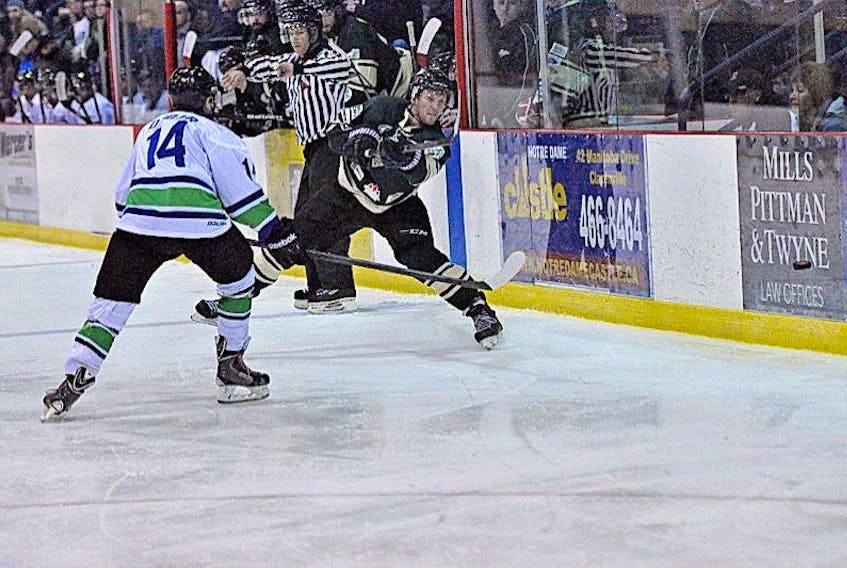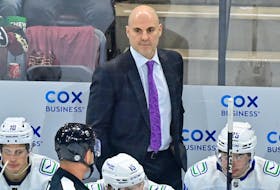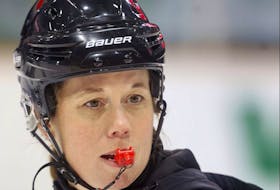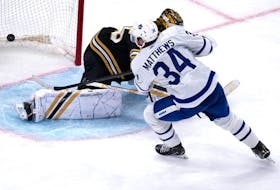So when the 27-year-old from Mount Pearl found out last year that his life as an athlete was in jeopardy due to a mysterious heart condition, the irony wasn’t lost on O’Keefe.
“I’ve always been the kind of guy to leave it all on the table, and give it everything I’ve got. That’s kind of what made my heart the way it was.
“I push it until my heart rate is through the roof. That’s when I get tired and I’ll go change up. And then I’m back out there again. I guess I just worked my heart a little too hard.
“It’s kind of ironic.”
Last June, just two weeks before he was set to join the Canadian men’s ball hockey squad at the 2015 world championships in Zug, Switzerland — his third turn with the national senior team and fourth overall having been part of the 2008 national junior squad that won gold in St. John’s that summer — an anomaly showed up on an EKG performed as part of his physical testing for the Royal Newfoundland Constabulary’s cadet training program.
At first, doctors diagnosed it ARVC, a muscle disease that can potentially cause lethal heart rhythm abnormalities resulting in sudden death, especially during strenuous exercise.
“At that point, I thought I was never going to get to play again,” says O’Keefe, who even went so far as to return the new equipment he had purchased for worlds.
“I was told I’d never play sports again, I’d never be able to do anything, that I’d need a defibrillator. I was kind of in this weird little zone where I wasn’t sure what I should do.”
O’Keefe and his mother, Lori, researched heart conditions occurring among elite athletes and turned up ‘athlete’s heart’, a condition that’s common in athletes who exercise more than an hour a day and results in an enlarged heart and resting heart rate lower than normal.
After having the suggestion dismissed by his original doctor, O’Keefe opted to get the opinion of local cardiologist Dr. Sean Connors, who acknowledged there was something at play but further testing would be required.
“They did between six and eight different tests and I finally did get the MRI, which was supposed to be the be-all, tell-all. But they had nothing to base it on, so they couldn’t compare my heart to when I was younger,” he explains.
Sure enough, the MRI showed that he had an enlarged heart, but without being able to determine whether the organ had been that way his entire life, Connors advised his patient to wait another three months and come back for another MRI.
Potentially fatal heart condition aside, the waiting was the hardest part for O’Keefe.
This past fall, a second MRI revealed that his heart had shrunk by 2 millimetres.
“It was probably the best news I could have heard,” says O’Keefe.
Dr. Connors gave him the green light to ease back into his regular fitness regimen, but after having sat idle for close to six months , that in itself was challenging.
“I’ve never taken more than a few weeks off in terms of keeping in shape, so when I was trying to get back to where I was at, it was tough,” he said. “It felt like my heart was going to burst out through my chest a couple of times.”
He credits Connors with giving him the assurances needed to start feeling normal again.
O’Keefe played four seasons in Quebec Major Junior Hockey League with the St. John’s Fog Devils and Montreal Juniors. From there he played by four more of Canadian university hockey with Saint Mary’s and two seasons in the ECHL.
Related story
O’Keefe says no to pro
Following his stint at pro, O’Keefe joined the Gander Flyers of the Central West Senior Hockey League.
“Playing full-tilt for your whole life and then trying to step back and calm down was a difficult transition,” he says.
O’Keefe, who will continue to have MRI scans every six months, did travel to Switzerland with the Canadian team last June, but didn’t play in the tournament. (Though he did inquire with Connors about playing a little bit on the team’s powerplay unit, a idea was quickly shot down by the cardiologist.)
This week, he learned that he is recipient of the International Street and Ball Hockey Federation (ISBHF) Robert Mueller Memorial Award. Named in memory of the late German hockey and street hockey player who overcame a malignant brain tumor in 2006 and returned to a professional career before succumbing to brain cancer in 2009, it is presented to an athlete who continues to show leadership and passion for the sport in the face of challenging odds.
“It was quite the fright when I initially got the news, but I didn’t want to stay home and sulk, so I decided to go over there and help the coach as best I could,” says O’Keefe, who ended up doing some stats work from the press box and lending encouragement to his teammates in the dressing room.
Newfoundland and Labrador Ball Hockey Association president Steve Power, who was also in Zug doing colour commentary alongside play-by-play man George Scott, says O’Keefe was “like a cat on a hot tin roof” while watching his teammates play.
“I don’t think I’ve ever seen someone literally in pain watching a game, and it had nothing to do with his heart condition,” says Power. “He wanted to play that bad and that team needed him that bad. He would have been a really big help to him.”
At one point in the week, he brought O’Keefe on board to offer some commentary, but that didn’t last long as Power says the defenceman was too intense watching the game.
“Not to be able to play was not a fun experience, but going over there the guys took me under their wing and I felt like I was part of the team. Everyone was great and it was fun trip, the only thing I’d change is being allowed to play.”
That’s the heart of a competitor.
Twitter: @telykenn
So when the 27-year-old from Mount Pearl found out last year that his life as an athlete was in jeopardy due to a mysterious heart condition, the irony wasn’t lost on O’Keefe.
“I’ve always been the kind of guy to leave it all on the table, and give it everything I’ve got. That’s kind of what made my heart the way it was.
“I push it until my heart rate is through the roof. That’s when I get tired and I’ll go change up. And then I’m back out there again. I guess I just worked my heart a little too hard.
“It’s kind of ironic.”
Last June, just two weeks before he was set to join the Canadian men’s ball hockey squad at the 2015 world championships in Zug, Switzerland — his third turn with the national senior team and fourth overall having been part of the 2008 national junior squad that won gold in St. John’s that summer — an anomaly showed up on an EKG performed as part of his physical testing for the Royal Newfoundland Constabulary’s cadet training program.
At first, doctors diagnosed it ARVC, a muscle disease that can potentially cause lethal heart rhythm abnormalities resulting in sudden death, especially during strenuous exercise.
“At that point, I thought I was never going to get to play again,” says O’Keefe, who even went so far as to return the new equipment he had purchased for worlds.
“I was told I’d never play sports again, I’d never be able to do anything, that I’d need a defibrillator. I was kind of in this weird little zone where I wasn’t sure what I should do.”
O’Keefe and his mother, Lori, researched heart conditions occurring among elite athletes and turned up ‘athlete’s heart’, a condition that’s common in athletes who exercise more than an hour a day and results in an enlarged heart and resting heart rate lower than normal.
After having the suggestion dismissed by his original doctor, O’Keefe opted to get the opinion of local cardiologist Dr. Sean Connors, who acknowledged there was something at play but further testing would be required.
“They did between six and eight different tests and I finally did get the MRI, which was supposed to be the be-all, tell-all. But they had nothing to base it on, so they couldn’t compare my heart to when I was younger,” he explains.
Sure enough, the MRI showed that he had an enlarged heart, but without being able to determine whether the organ had been that way his entire life, Connors advised his patient to wait another three months and come back for another MRI.
Potentially fatal heart condition aside, the waiting was the hardest part for O’Keefe.
This past fall, a second MRI revealed that his heart had shrunk by 2 millimetres.
“It was probably the best news I could have heard,” says O’Keefe.
Dr. Connors gave him the green light to ease back into his regular fitness regimen, but after having sat idle for close to six months , that in itself was challenging.
“I’ve never taken more than a few weeks off in terms of keeping in shape, so when I was trying to get back to where I was at, it was tough,” he said. “It felt like my heart was going to burst out through my chest a couple of times.”
He credits Connors with giving him the assurances needed to start feeling normal again.
O’Keefe played four seasons in Quebec Major Junior Hockey League with the St. John’s Fog Devils and Montreal Juniors. From there he played by four more of Canadian university hockey with Saint Mary’s and two seasons in the ECHL.
Related story
O’Keefe says no to pro
Following his stint at pro, O’Keefe joined the Gander Flyers of the Central West Senior Hockey League.
“Playing full-tilt for your whole life and then trying to step back and calm down was a difficult transition,” he says.
O’Keefe, who will continue to have MRI scans every six months, did travel to Switzerland with the Canadian team last June, but didn’t play in the tournament. (Though he did inquire with Connors about playing a little bit on the team’s powerplay unit, a idea was quickly shot down by the cardiologist.)
This week, he learned that he is recipient of the International Street and Ball Hockey Federation (ISBHF) Robert Mueller Memorial Award. Named in memory of the late German hockey and street hockey player who overcame a malignant brain tumor in 2006 and returned to a professional career before succumbing to brain cancer in 2009, it is presented to an athlete who continues to show leadership and passion for the sport in the face of challenging odds.
“It was quite the fright when I initially got the news, but I didn’t want to stay home and sulk, so I decided to go over there and help the coach as best I could,” says O’Keefe, who ended up doing some stats work from the press box and lending encouragement to his teammates in the dressing room.
Newfoundland and Labrador Ball Hockey Association president Steve Power, who was also in Zug doing colour commentary alongside play-by-play man George Scott, says O’Keefe was “like a cat on a hot tin roof” while watching his teammates play.
“I don’t think I’ve ever seen someone literally in pain watching a game, and it had nothing to do with his heart condition,” says Power. “He wanted to play that bad and that team needed him that bad. He would have been a really big help to him.”
At one point in the week, he brought O’Keefe on board to offer some commentary, but that didn’t last long as Power says the defenceman was too intense watching the game.
“Not to be able to play was not a fun experience, but going over there the guys took me under their wing and I felt like I was part of the team. Everyone was great and it was fun trip, the only thing I’d change is being allowed to play.”
That’s the heart of a competitor.
Twitter: @telykenn









